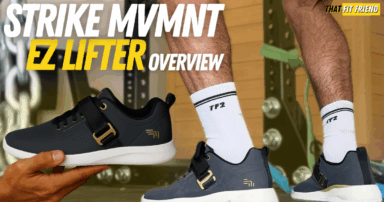If you’re a weathered gym rat, then you’re likely familiar with the term accommodating resistance. This is a training tool that is used to produce favorable outcomes for strength and power.
Accommodating resistance is additional resistance that is added to straight weight to intentionally increase or decrease difficulty and output based on the range of motion you’re working through.
Bands and chains are the most popular forms of accommodating resistance and they can be used to increase power and strength.
Chains and resistance bands are both popular accommodating resistance techniques for improving squat strength and power. They can also be useful for working through sticking points and improving squat form.
Author’s Note: If you want to learn more about the mistakes to avoid with chains and resistance bands, how to set them up properly, and how to program them, check out my chains versus bands video below!
What Is Accommodating Resistance?
Accommodating resistance is a form of added resistance that will manipulate an exercise’s difficulty through specific ranges of motion. In most cases, accommodating resistance is designed to increase work output for a narrower range of motion.
For example, if you’re barbell squatting and using chains, then you’ll have the most added chain load at lockout and the least amount at the bottom of your squat. As you stand back up, that chain’s weight will steadily increase as you get closer to lockout.
Chains Vs Resistance Bands Differences
There are three key differences that I think everyone should know when using chains versus resistance bands for squatting and training in general. Note, there are more differences outside of these three, but these are arguably the most important to understand.
1. Chains Are More Linear
The first difference is that chains will produce a more linear load when training. This means that a chain’s loading will be more vertical in nature with a more gaugeable level of resistance through specific ranges of motion.
When you descend in a squat with a chain attached to a barbell, the chain’s load will slowly decrease with deeper hip and knee flexion. Then, as you stand back up, the chain’s load slowly increases with your range of motion.
There is a stability component to using chains, but since there are always chainlinks in contact with the ground, the chain will demand less than using resistance bands, and gravity will be the main player manipulating how heavy or light the chain feels.
2. Resistance Bands Are More Radical
When you squat with resistance bands, you need a higher level of stability because the bands are actively pulling you toward the ground versus just hanging from the barbell.
This active pull towards the ground will challenge your balance and stability more because any forward or backward shifting while squatting will increase how the band feels on the body as your center of mass shifts.
As opposed to chains, a band can place more stress on the body from a vertical and horizontal perspective. There isn’t only gravity manipulating how you feel the load, but instead, there’s a band’s tension and your momentum.
3. They Require Different Skill Levels
Outside of their loading styles and how they place stress on your body when squatting, another major difference is the “who” behind who should be using chains and resistance bands.
In general, most lifters and athletes can benefit from following the guidelines below regarding using chains and resistance bands.
- Chains = More beginner friendly. They can be easier to scale and progress with because of their linear loading style. They also require a little less form efficiency and you can get away with saving squats a little better with chains.
- Resistance Bands = Intermediate and advanced lifters. Bands can be a lot more variable with how they’ll manipulate your squat from an intensity point of view. Additionally, you’ll want to have a proficient squat form before using bands.
Coach’s Note: There will obviously be some contexts outside of these where exceptions can exist, but for most recreational lifters, the above guidelines can be great to keep in mind when incorporating accommodating resistance for squats.
Benefits of Using Chains for Squats
There are multiple benefits that come along with using chains for squats. Below are three of the most notable benefits to remember when programming squats with chains.
1. Good Accommodating Resistance Option for Beginners
There’s not necessarily a “right time” to start playing with and using accommodating resistance. I would recommend having a really strong grasp on your squat form before using chains and bands, but there’s no level of strength you need before doing so.
The first benefit of using chains for squats is that they can be great for beginners wanting to experiment with this training technique. Chains will be a little more straightforward regarding how they load and manipulate your squat.
Since they apply a more linear load, it’s easier to track “how much” additional resistance you’re getting when using chains, so for a beginner who’s likely following a linear periodization program, a chain can be an easy tool to implement.
2. Great for Working Through Sticking Points
Another benefit of using chains for squats is how they can help you work through sticking points. If your squat sticking point is coming out of the hole or close to lockout, then chains can be an awesome tool to experiment with.
A chain’s load is relatively nothing at the bottom of the squat and as you stand its weight will slowly increase so it can be useful for forcing you to fight through the range of motion you struggle with by forcing you to produce more force and power for that ROM.
This can be great for building both your physical strength and mental relationship with certain loads. Chains can help your body acclimate to “feeling” heavier weights on your back in a limited and scalable fashion.
3. Useful for Strategic Exposure
To add to the above, chains can also be great for exposing you to heavier loads without burying you in fatigue. This can be great for lifters that want to slowly build to heavier goal-focused weights and limit some of their fatigue in doing so.
- Lifter 1: Squats 3 sets of 365 lbs for 5 reps with an added 40 lbs of chain weight. This gives them exposure to 405 lbs at the top of their squat and 365 lbs at the bottom.
- Lifter 2: Squats 3 sets of 405 lbs for 5 reps.
Across these three sets, lifter 2 is accruing more total load. This total load will then make liter’s 2 effort exertion higher which can translate to more overall fatigue.
Benefits of Using Resistance Bands for Squats
Similar to chains there are countless benefits to using resistance bands for squats and these benefits will be contextual to your squat needs and goals. Below are three of my favorite benefits of using resistance bands.
1. Useful for Training Stability
The first benefit of using resistance bands for squats is their ability to increase the stability demands of your reps. If you find that you’re constantly losing balance at moderate to heavier loads due to balance issues, then using a band could be useful.
For example, let’s say that you notice when squatting 365 lbs, you tend to lose weight forward, and your torso folds a little bit. When squatting with a band, this is going to be heightened, and the band is going to actively try to fold you over.
In practice, by using a load that sits below this threshold with a light resistance band, you can actively direct more attention towards fighting your torso folding and it can be a great way to build your ability to create balance and stability.
2. Great for Training Overspeed Eccentrics
Overspeed eccentrics is a training technique that was popularized by the late great Louie Simmons of Westside Barbell. This training technique is designed to optimize energy by loading a movement’s eccentric faster.
So, as you descend with a barbell in the squat, a resistance band’s active pull is going to overload the eccentric quicker than a straight weight would. The band’s tension and amount of pull will be the highest at the top of a squat then it will dissipate as you lower.
This can be great for lifters and athletes who struggle to create power out of the hole in the squat or need help with accelerating more proficiently when standing up with weight.
By utilizing the band’s variable resistance, you can in theory, create more kinetic energy output by shifting the band’s resistance through the overloaded eccentric into an accelerated concentric.
3. Awesome for Training Through Sticking Points
Similar to chains, resistance bands can be great for busting through sticking points. As you stand up from a squat with bands on the bar you’ll have to actively work through a resistance that will increase as you get closer to lockout.
In the context of sticking point ranges of motion in the squat, resistance bands can be useful for lifters that struggle with the range of motion just out of the hole in their squat or close to lockout.
Takeaway Thoughts
Accommodating resistance with the use of chains and resistance bands can be an awesome technique and tool for improving a lifter’s squat strength and power output.
Chains can be a better tool for beginners wanting to learn more about accommodating resistance, and resistance bands can be great for more advanced lifters wanting to train overspeed eccentrics.
If you have additional questions about the chains and resistance bands for squatting, drop a comment below or reach out to me personally via Instagram (@jake_boly or @that_fit_friend).
















Add a Comment